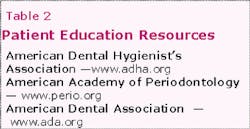Firing up patients' home care motivation
by Carol A. Jahn, RDH, MS
Most dental hygienists agree that one of the most difficult aspects of providing care is achieving compliance with recommended self-care regimens. In defining this gap between what is recommended and what actually occurs, patients often are described as uninterested, unmotivated, apathetic, or even lazy. Repeated attempts at behavior change often result in frustration for both parties. While changing behavior is difficult, some easy strategies can be implemented by practitioners to customize care and improve compliance.
What motivates adults?
It has been widely recognized that adults learn differently from children. While children are dependent on a teacher or parent to instruct them, adults usually are motivated to learn based upon need. Problem-centered or goal-oriented learning, such as CPR certification, is preferred. The power to choose what you want to learn also is very important. For example, when deciding on a continuing-education course, most of us are much more enthusiastic about courses we self-select rather than one an employer has required us to take. Likewise, patients may experience similar feelings when we convey our message of regular flossing without finding out first what is really important to them.
Implications for dental hygienists
Adults perform better when they take responsibility for their own learning — including self-care skills. The upside of this is that it helps balance the burden between the patient and the dental hygienist. However, this customized approach requires thought, consideration, and good listening skills on the part of the professional, not to mention significant trial and error! The following are some easy suggestions for developing a customized approach and meeting the primary needs of adult patients.
Promoting self-direction: Rather than identifying for patients areas that need improvement, begin by asking them how they feel they are doing. Good trigger questions to ask might be:
- Where do you think you could improve?
- Are you satisfied with your oral health?
- What are you most concerned about? Appearance? Good breath? Keeping your teeth?
Encourage patients to be honest and realistic. It's still OK to point out to patients areas you feel are of the greatest concern. However, if you encourage patients to identify their own oral-health status and needs, not only will their dental awareness be enhanced, but so will your understanding of what oral health issues are important to them.
Expound upon previous experience: In addition to reviewing past dental experiences and history, other information you may want to learn includes:
- What products have they previously used?
- What did they like or dislike about the product?
- Did they feel the product made a difference?
It also is important to find out how much time the patient has or is willing to devote on a daily basis to self-care. Take into consideration extenuating circumstances such as business travel, physical limitations, or the ability to afford any recommended device. Once you have this information in hand it is easier to build on past success and avoid previous pitfalls.
Assess how open or ready they seem to be to making changes: The ability and readiness to change is different for everyone. People often pass through several stages before actually incorporating change into their life. (See Table 1.) An important point to remember is that patients may be resistant or vary in their willingness to change. Patient education will need to be tailored accordingly. For example, patients who refuse to acknowledge the severity of their dental problem will probably not be open to being told "daily flossing is a must." Changing behavior requires time and patience. Education is the keystone, but it must be carefully planned and customized to the level of readiness that the patient exhibits.
Focusing on the problem or goal: Most dental hygienists are adept at focusing on the problem or goal, such as reducing plaque or bleeding. However, the tendency to "scare" the patient by discussing "worst-case scenario outcomes" should be avoided. This is not to say that patients should not be informed of the consequences of their lack of compliance, but be realistic. Try to focus on the positive outcomes of improving their self-care habits or treatment, such as a better appearance, better breath, or tooth retention. Enhance your credibility by providing your patients with appropriate resources that support your information and instruction. (See Table 2.)
Practical applications
The dental hygiene appointment offers several opportunities for the hygienist to incorporate new, customized strategies for compliance and motivation into patient care. Power devices have been shown to be widely accepted by patients and improve compliance. The availability of effective, powered self-care devices provides many choices. What must be fundamentally understood, however, is there are no "quick fixes." To be maximally effective, most techniques take organization, preparation, and time. Here are some suggestions for an effective start:
Identify all possible devices, including automatic toothbrushes, power flossers, and oral irrigators that have research to support their efficacy. Be sure to include as many different devices as possible. Keep in mind that the best device, as long as it is safe and effective, is the one the patient likes, regardless of how you feel about it. Remember to hold personal preferences or biases at bay and focus on what the patient likes and needs. While carrying only one type of product — such as only one brand of power toothbrush — may be convenient, rarely does one product please or work for all patients. Incorporate different features and price ranges in the products you offer. For example, even if you like an oscillating brush head or sonic technology, make sure other types of power toothbrushes are available.
Trade shows, journal advertising, and Web sites are excellent ways to learn about the various products. However, don't forget to look for what's available at your local retailer or drug chain. These are the stores where your patients shop for products.
Secure working demonstration models and brochures on the devices. Many manufacturers are happy to provide these to you, either complimentary or at a discounted professional price. You can learn about these offers by either calling customer service or looking on their Web site.
Patients benefit from having products to touch and feel. It is also important for them to have something to take with them when they leave, so be sure to have product brochures on hand. They will help to reinforce the need for the device. It also is helpful if you can provide patients with product photos to make purchasing easier. Some manufacturers provide rebates for products when purchased at retail, so be sure inquire about them when speaking with the manufacturer.
Arrange a self-care product display in your office that is easy for patients to see. This is important because it will encourage patients to think about their self-care needs. When it comes to motivation, it is preferable for the patient to ask you about the device, rather than have you be the one to bring it up. Additionally, some patients may be more comfortable looking at the products first and getting familiar with them before asking about them. Having the products available in a universal area signifies that the entire dental team feels the use of these devices is important, not just the hygienists. While the dental hygienist often is the catalyst in getting the patient to use a power device, credibility is enhanced when the entire office stands behind the recommendation.
Let the patient explore and choose. This is the pinnacle of customization. Keep in mind, though, that the first choice that patients make may be that they are "not ready" or they don't see the need. Patients also may choose a device or devices that they think they will use. Help guide patients to products that may be beneficial for their particular situation, but be sure to give them a choice so that they ultimately make the decision and the accountability resides with them.
Encourage your patients to be informed consumers and to ask questions such as:
- Why is this a good product?
- How will this product help me?
- Has the product been studied?
- What are my alternatives?
- How much does it cost? Can I get something cheaper that works as well?
- Where can I buy it?
Know where the patient can get the product and the approximate cost. Unless your office stocks the product, it is very important to know where the products are available. Nothing will dampen the enthusiasm of your patients for the product more quickly than not being able to locate the item. Be sure to include local retail and drug stores near your office in your listing, as well as Web-based sites for online purchasing. If you are unsure about the location of a product, consult with the product manufacturer. Remember to give patients an accurate estimate of the cost of the product. Having this information emphasizes to patients that this product is important.
Call or email the patient a week or two after the appointment. Compliance can be enhanced if you take the time to find out if your patients were able to purchase the product and/or what kind of questions they might have regarding its use. If a patient is having difficulty, schedule this person for a 15- to 20-minute appointment to go over the use of the product.
Partner with your patients
Often, dental hygienists feel the educational message itself should be important enough to stimulate change. However, this is rarely the case. Rather than informing patients, dental hygienists have the opportunity to partner with their patients and empower them to take charge of their own oral health. Customization is the key. (See Table 3.) Automated self-care devices provide an easy and effective way to begin to implement customized strategies for increasing compliance into everyday practice.
Suggested Reading
Changing for Good: A Revolutionary Six-Stage Program for Overcoming Bad Habits and Moving Your Life Positively Forward. James O. Prochaska, John C. Norcross, Carol C. DiClemente. Avon Books. ISBN: 0-380-72572-X
Health Behavior Change: A Guide for Practitioners. Stephen Rollnick, Pip Mason, Chris Butler. Churchill Livingstone. ISBN: 0-443-05850-4.
Carol A. Jahn, RDH, MS, is the educational programs manager for Waterpik Technologies. She designs educational programs for dental professionals in a variety of formats — CD-ROMs, in-print, and lectures. She lectures nationally, and has published numerous articles. She can be reached by phone at (800) 525-2020, Ext. 8565, or by email at [email protected]. Visit the company's Web site at www.waterpik.com.




